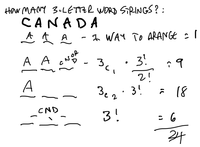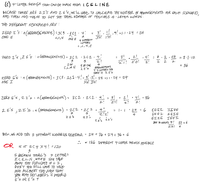You are using an out of date browser. It may not display this or other websites correctly.
You should upgrade or use an alternative browser.
You should upgrade or use an alternative browser.
Word strings and permutation
- Thread starter ry7
- Start date
This isn't quite correct. Each word has one of the following sets of I's and E's
I, E, II, IE, EE, IIE, IEE, IIEE
In the case of I or E we have \(\displaystyle \dbinom{2}{1}\dbinom{4}{1}3!\)
The first factor selects whether we have I or E. The second factor selects the slot in the word for it.
Then the third factor recognizes that we use the 3 letters not I or E and all permutations of them are valid.
In the case of IIE or IEE we have \(\displaystyle \dbinom{2}{1}\dbinom{4}{1}\dbinom{3}{1}\dbinom{3}{1}\)
The first factor selects whether we have two I's or two E's, the second factor selects the slot for the single I or E,
the third factor selects the letter from the other 3, and the fourth factor selects the slot for the other letter.
I'll let you work up the numbers for IE, II, EE, and IIEE. It's all very similar to above.
Then add up all numbers. You should get 270.
I, E, II, IE, EE, IIE, IEE, IIEE
In the case of I or E we have \(\displaystyle \dbinom{2}{1}\dbinom{4}{1}3!\)
The first factor selects whether we have I or E. The second factor selects the slot in the word for it.
Then the third factor recognizes that we use the 3 letters not I or E and all permutations of them are valid.
In the case of IIE or IEE we have \(\displaystyle \dbinom{2}{1}\dbinom{4}{1}\dbinom{3}{1}\dbinom{3}{1}\)
The first factor selects whether we have two I's or two E's, the second factor selects the slot for the single I or E,
the third factor selects the letter from the other 3, and the fourth factor selects the slot for the other letter.
I'll let you work up the numbers for IE, II, EE, and IIEE. It's all very similar to above.
Then add up all numbers. You should get 270.
I still don’t understand this very well.
For example, for IIEE, is it 4!/2!
(4 spots for the letters to go in, divided by 2 factorial times 2 factorial because there are 2 E and 2 I’s that you don’t want to double count. Argh, I thought I had a handle on combinations and permutations but this question is making me understand less. For example the below makes perfect sense to me, but not the ICELINE question

For example, for IIEE, is it 4!/2!
(4 spots for the letters to go in, divided by 2 factorial times 2 factorial because there are 2 E and 2 I’s that you don’t want to double count. Argh, I thought I had a handle on combinations and permutations but this question is making me understand less. For example the below makes perfect sense to me, but not the ICELINE question

pka
Elite Member
- Joined
- Jan 29, 2005
- Messages
- 11,978
Consider the word \(\displaystyle MISSISSIPPI\) that is a string of eleven letters not all unique.I still don’t understand this very well.
For example, for IIEE, is it 4!/2!
(4 spots for the letters to go in, divided by 2 factorial times 2 factorial because there are 2 E and 2 I’s that you don’t want to double count. Argh, I thought I had a handle on combinations and permutations but this question is making me understand less. For example the below makes perfect sense to me, but not the ICELINE question
Subscript the repeated letters: \(\displaystyle MI_1S_1S_2I_2S_3S_4I_2P_1P_2I_4\). Thus we have eleven unique letters.
Now there are \(\displaystyle 11!\) ways to arrange that string. The subscripted S's can be arranged in \(\displaystyle 4!\) ways
The subscripted I's can be arranged in \(\displaystyle 4!\) ways. The subscripted P's can be arranged in \(\displaystyle 2!\) ways.
Of the \(\displaystyle 11!\) rearrangements using the subscrippts, we take just one and remove all subscripts the we have allot of duplicates.
So \(\displaystyle \frac{11!}{4!\cdot 4!\cdot 2!}\) would count the strings with no subscripts.
Allot of textbooks refer to this as the MISSISSIPPI problem.
The word \(\displaystyle CANADA\) can be arranged in \(\displaystyle \frac{6!}{3!}\) ways.
The string \(\displaystyle WXXYYYZZZZ\) can be rearranged in \(\displaystyle \frac{10!}{2!\cdot 3!\cdot 4!}\) ways.
pka
Elite Member
- Joined
- Jan 29, 2005
- Messages
- 11,978
But you have done that. If you are asking for a recipe lets go back to \(\displaystyle MSSISSIPPI\).Yes, I have no problem understanding that. I’m actually looking for help on how to count the E, I, EI, EII etc subsets in the word ICELINE, making 4 letter words
How many four letter strings can we make with those eleven letters?
Here is my plan. We can have no, zero, repeats; one letter repeated; two letter repeated; one letter repeated three times; or one letter repeated four times.
Have I listed all possibles? If so then proceed to count.
\(\displaystyle \begin{align*}\text{No repeats} &\text{ is }4! \\\text{one repeat} &\text{ is }\binom{3}{1}\cdot\frac{4!}{2!}
\\\text{two repeat} &\text{ is }\binom{3}{2}\cdot\frac{4!}{(2!)^2}
\\\text{one repeat three times} &\text{ is }\binom{2}{1}\cdot\binom{3}{1}\cdot\frac{4!}{3!}
\\\text{one repeat four times} &\text{ is }\binom{2}{1}\cdot\frac{4!}{4!} \end{align*}\)
In more complicated cases the headache comes is listing all the possible cases.
If that is what you are asking then there is no easy answer.
I hope I have helped somewhat.

